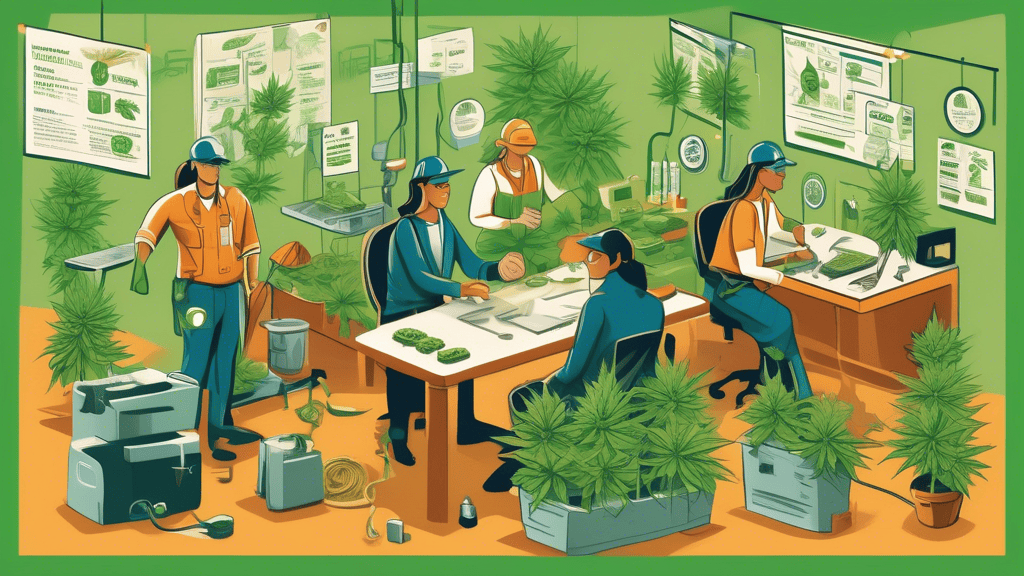Navigating Workers’ Compensation in the Cannabis Industry
As the cannabis industry experiences unprecedented growth, it opens a plethora of employment opportunities across various sectors—from cultivation and processing to retail. This booming industry’s expansion necessitates a keen understanding of the intricate landscape of workers’ compensation, a crucial aspect for both employees and employers to navigate effectively. Workers’ compensation is vital in safeguarding the well-being of the workforce, ensuring that they receive appropriate care and compensation in the event of work-related injuries or illnesses.
This article aims to provide a comprehensive guide to understanding workers’ compensation in the cannabis industry, a rapidly evolving sector subject to distinctive regulatory challenges and safety concerns. We’ll explore the regulatory landscape, highlighting the key differences and conflicts between federal and state regulations and the specific workers’ compensation laws applicable to cannabis workers in various states. Additionally, we will delve into the common injuries and safety risks associated with each stage of the cannabis supply chain, emphasizing the importance of robust workplace safety programs and standard operating procedures.
Moreover, the article will offer practical advice on navigating the complexities of workers’ compensation claims in the cannabis industry. From detailed steps on filing a claim and gathering necessary documentation to addressing common challenges faced by employees, we aim to equip both workers and employers with the knowledge needed to manage and prevent compensation issues effectively. By understanding these critical aspects, stakeholders in the cannabis industry can ensure a safer, more compliant, and more productive working environment.
Introduction to Workers’ Compensation in the Cannabis Industry
Overview of the Cannabis Industry’s Growth and Its Impact on Employment
The cannabis industry has witnessed exponential growth over the past decade, driven by increasing legalization and a surge in public acceptance. According to recent market research, the legal cannabis market is poised to exceed $40 billion by 2025, fostering job creation across various domains such as cultivation, processing, distribution, and retail. This rapid expansion has not only generated substantial economic benefits but has also resulted in a diversified workforce with unique occupational demands and challenges.
Employment in the cannabis sector spans a wide range of roles, from agricultural workers and laboratory technicians to marketing specialists and retail staff. As the number of workers continues to rise, so does the need for a robust understanding of the mechanisms in place to protect their wellbeing, particularly through workers’ compensation systems.
Importance of Understanding Workers’ Compensation in This Rapidly Evolving Sector
Workers’ compensation is a critical component of employee protection, ensuring that those who suffer work-related injuries or illnesses receive necessary medical care and financial compensation. For the burgeoning cannabis industry, comprehending the nuances of workers’ compensation is paramount. Unlike more established industries, cannabis enterprises face unique challenges due to the evolving legal landscape, the nature of work environments, and varying levels of regulatory oversight.
With the pace at which the cannabis industry evolves, staying informed of both state-specific regulations and the federal framework surrounding workers’ compensation is essential for employers and employees alike. Misunderstanding or overlooking these regulations can lead to costly legal disputes, financial losses, or inadequate care for injured workers.
Furthermore, the inherent risks associated with cannabis operations—ranging from chemical exposure in cultivation to repetitive strain injuries in processing—necessitate tailored workers’ compensation strategies. Ensuring proper coverage not only safeguards employees but also strengthens the industry’s stability and reputation.
Brief Outline of What the Article Will Cover
To equip stakeholders with the knowledge they need to navigate workers’ compensation in the cannabis sector, this article will delve into several critical aspects. Following this introductory segment, we will examine the regulatory landscape, highlighting the key differences and conflicts between federal and state regulations and providing an overview of state-specific workers’ compensation laws for cannabis workers. We will also explore the role of the Occupational Safety and Health Administration (OSHA) in this context.
Subsequent sections will address common injuries and safety concerns indigenous to the cannabis industry, discussing workplace hazards in different environments such as cultivation sites, processing facilities, and retail stores. Emphasizing the importance of workplace safety programs and standard operating procedures, we will outline strategies to mitigate risks and enhance employee protection.
Finally, the article will provide a comprehensive guide on navigating workers’ compensation claims in the cannabis industry. This includes a step-by-step process for filing claims, essential documentation and evidence requirements, and the common challenges faced by cannabis industry workers in securing compensation. Additionally, we will offer practical tips for employers on managing and preventing workers’ compensation claims, thus fostering a safer and more compliant work environment.

Regulatory Landscape for Workers’ Compensation in Cannabis
The cannabis industry’s rapid growth presents unique challenges, particularly in the realm of workers’ compensation. Understanding the regulatory landscape is crucial for both employers and employees to navigate this complex terrain successfully.
Federal vs. State Regulations: Key Differences and Conflicts
The regulation of workers’ compensation in the cannabis industry is complicated by the dichotomy between federal and state laws. Federally, cannabis remains classified as a Schedule I controlled substance under the Controlled Substances Act. This classification creates a significant conflict, as many states have legalized cannabis for medical or recreational use. Consequently, the federal stance impacts various aspects of employment and workers’ compensation, fostering an environment fraught with legal ambiguities.
State regulations, conversely, vary widely and are more permissive toward cannabis operations. Each state enacts its own workers’ compensation laws, designed to protect both employers and employees. These disparities can result in interstate confusion and challenges, particularly for multinational cannabis businesses operating in multiple jurisdictions. Hence, understanding and adhering to these state-specific laws is paramount for compliance and effective risk management in the industry.
Overview of State-Specific Workers’ Compensation Laws for Cannabis Workers
Each state that has legalized cannabis has established unique workers’ compensation guidelines. For instance, California, one of the largest cannabis markets in the U.S., mandates that all employers, including those in the cannabis industry, provide workers’ compensation insurance. This insurance covers medical expenses and wage replacement for employees injured on the job, ensuring their rights are protected regardless of the industry’s federal status.
Conversely, states like Colorado and Oregon have specific provisions that address workers’ compensation within their cannabis sectors. In Colorado, employers must carry workers’ compensation insurance, and the state’s policies are designed to accommodate the nuances of the cannabis industry. Oregon’s laws also mandate coverage while providing detailed frameworks on claim processes and dispute resolution, tailored to suit the intricate nature of cannabis businesses.
It is essential for cannabis businesses to stay updated on their state’s specific regulations and ensure their insurance policies fully comply, to effectively avoid legal repercussions and financial liabilities.
The Role of OSHA (Occupational Safety and Health Administration) in the Cannabis Industry
OSHA plays a pivotal role in regulating workplace safety standards in the cannabis industry, despite the industry’s unique regulatory status. OSHA’s mission to ensure safe and healthy working conditions extends to all workplaces, including cannabis operations, regardless of federal cannabis law.
OSHA mandates that employers provide a safe work environment, which includes adhering to guidelines for workplace safety, employee training, and hazard communication. For the cannabis industry, this involves specific safety protocols tailored to the activities within cultivation, processing, and retail sectors. These protocols may include measures to prevent injuries from repetitive tasks, exposure to chemicals, and machinery operation.
Moreover, OSHA encourages the implementation of comprehensive safety programs that proactively address potential hazards. These programs should include regular safety audits, employee safety training, and clear communication channels for reporting safety concerns. By adhering to OSHA’s standards, cannabis businesses can not only mitigate the risk of workplace injuries but also demonstrate their commitment to employee welfare and regulatory compliance, which can be particularly beneficial in this scrutinized industry.

Common Injuries and Safety Concerns in the Cannabis Industry
The burgeoning cannabis industry, while full of opportunities, is not without its unique set of challenges, particularly regarding workplace safety. Understanding these risks and implementing robust safety measures can significantly reduce the incidence of workplace injuries and associated workers’ compensation claims.
Overview of Common Workplace Injuries Specific to the Cannabis Sector
The cannabis industry encompasses various fields such as cultivation, processing, and retail, each presenting distinct hazards. One of the most common injuries in this sector is repetitive strain injuries (RSIs). These occur due to the repetitive tasks performed by workers, such as trimming plants, which often lead to musculoskeletal disorders.
Another prevalent issue is exposure to biological hazards. Workers frequently handle plant material, which can cause allergic reactions or respiratory issues, especially in poorly ventilated spaces. Chemical exposure from pesticides and other growing aids poses additional risks, potentially leading to skin conditions or serious illness if proper precautions are not taken.
Additionally, physical injuries such as cuts, bruises, and lacerations are common, particularly during cultivation and processing stages where sharp tools and machinery are used. Slips, trips, and falls are also frequent, especially in environments where irrigation systems or spills create slippery surfaces.
Safety Risks in Cultivation, Processing, and Retail Environments
Each part of the cannabis industry presents its own set of safety risks:
- Cultivation: Workers in cultivation facilities are often exposed to harsh climates and the physical demands of bending, lifting, and climbing. The use of various chemicals and exposure to mold and mildew also heighten the risk of health complications.
- Processing: In processing, employees operate sophisticated machinery for extraction and refinement. The improper handling of equipment can lead to significant injuries, while the use of flammable substances introduces the risk of fire and explosions.
- Retail: While seemingly less hazardous, retail environments are not devoid of risks. Employees may encounter ergonomic issues from prolonged standing or injuries from repetitive tasks, such as stocking shelves. The handling of large sums of money also introduces security risks, making workers potential targets for theft and violence.
Importance of Workplace Safety Programs and Standard Operating Procedures
Given the myriad of risks present, the implementation of comprehensive workplace safety programs is crucial. These programs should include thorough training on the proper handling of equipment and chemicals, emergency response protocols, and health and safety best practices.
Standard Operating Procedures (SOPs) play an essential role in mitigating risks. These documented guidelines ensure that each task is performed safely and consistently, thus reducing the likelihood of accidents. SOPs should be regularly reviewed and updated to reflect current best practices and regulatory changes.
The emphasis on workplace safety not only fulfills regulatory obligations but also fosters a culture of safety, enhancing overall productivity and employee morale. Investing in safety programs and stringent SOPs can lead to fewer workers’ compensation claims, ultimately saving employers costs and reducing downtime due to injuries.
In conclusion, acknowledging and addressing the unique safety concerns of the cannabis industry is imperative for the well-being of its workforce. By identifying common injuries, understanding the specific risks associated with each segment, and implementing effective safety protocols, the industry can create a safer environment for its employees.

Navigating Workers’ Compensation Claims in the Cannabis Industry
Step-by-Step Guide to Filing a Workers’ Compensation Claim
Filing a workers’ compensation claim in the cannabis industry entails several crucial steps. Initially, the worker must report the injury to their employer as promptly as possible, ideally within 24 hours. Failure to promptly report can complicate the legitimacy of the claim. Next, the employee should seek medical evaluation and treatment, ensuring that all medical reports explicitly detail the injury and its connection to the workplace.
The employer is then responsible for notifying their insurance carrier about the incident. This kickstarts the formal claim process. Workers must complete the necessary claim forms, often provided by the employer or available through state-specific workers’ compensation boards. Timeliness in submitting these forms is paramount to avoid delays or denials.
Once submitted, the claim undergoes evaluation by the insurance carrier, which may involve further investigations or requests for additional information. Throughout this process, keeping thorough records and maintaining communication with all involved parties is essential.
Critical Documentation and Evidence Needed for Claims
Compiling robust documentation significantly enhances the success of a workers’ compensation claim. Essential documents include initial injury reports, comprehensive medical records, and witness statements if the injury was observed by colleagues. Photographic evidence of the injury and the accident scene can also substantiate the claim.
Medical reports should consistently connect the injury to specific workplace tasks. Additionally, maintaining a log of all treatments, doctor visits, and medical expenses related to the injury can support the financial aspects of the claim.
Documentation from the employer is equally vital. This includes incident reports, safety training records, and any correspondence related to the claim. A well-documented claim is less susceptible to disputes and delays.
Common Challenges Faced by Cannabis Industry Workers in Securing Compensation
The cannabis industry presents unique challenges for workers seeking compensation. Federal illegality creates a complex regulatory environment, often limiting access to standard workers’ compensation insurance policies offered in other industries.
Furthermore, the relatively new and rapidly evolving nature of the cannabis sector means that established protocols and safety standards may still be developing. This can lead to disputes over whether injuries are genuinely work-related or if they meet insurance policy criteria.
Insurance carriers may also be more stringent in evaluating claims due to the heightened risk perceptions associated with cannabis-related activities. Workers may face skepticism, especially in states with stringent regulations or less mature cannabis industries. Advocacy and legal support can be critical in overcoming these challenges.
Tips for Employers to Manage and Prevent Workers’ Compensation Claims
Proactive management and prevention of workers’ compensation claims are crucial for employers in the cannabis industry. Implementing robust safety programs and adhering to comprehensive standard operating procedures (SOPs) can significantly mitigate workplace injuries.
Regular safety training tailored to the specific hazards of the cannabis industry—be it cultivation, processing, or retail—ensures employees are well-versed in safe work practices. Conducting routine risk assessments and maintaining an open dialogue about safety concerns fosters a culture of safety.
Employers should also establish clear protocols for injury reporting and claim filing, ensuring that employees understand the procedures and feel supported throughout the process. Maintaining an in-house human resources or legal advisor with expertise in workers’ compensation can streamline the claims process and resolve issues promptly.
Furthermore, investing in quality workplace equipment and protective gear, and regularly maintaining these assets, can reduce the likelihood of accidents. By prioritizing workplace safety and being prepared to handle claims efficiently, employers can create a safer work environment and minimize the financial impact of workers’ compensation claims.
In conclusion, understanding and navigating workers’ compensation in the cannabis industry is essential for both employees and employers in this burgeoning sector. As the industry continues to expand, it brings with it a unique set of challenges and opportunities, largely shaped by a complex regulatory environment that differs significantly between federal and state jurisdictions. Employers must stay informed and compliant with these varying laws to ensure they provide adequate protection for their workforce.
Workers in the cannabis industry face specific safety risks, ranging from common injuries in cultivation and processing to retail-related hazards. Implementing comprehensive safety programs and adhering to standard operating procedures is not only a legal obligation but a critical step towards fostering a safe and productive work environment.
Filing a workers’ compensation claim in the cannabis sector requires navigating a detailed and often complicated process. Employees must be aware of the necessary documentation and potential hurdles they may encounter. It is crucial for employers to support their staff through this process by providing clear guidance and maintaining meticulous records to facilitate a smooth claims process.
Employers can significantly mitigate the risk of workers’ compensation claims through proactive measures, including thorough employee training, rigorous adherence to safety protocols, and prompt addressing of any workplace hazards. By fostering a culture of safety and compliance, the cannabis industry can continue its growth trajectory, ensuring a secure and supportive environment for its workforce.
In this evolving landscape, continuous education and adaptation are key. Both employees and employers must remain vigilant and responsive to changes in regulations and industry practices to navigate the complexities of workers’ compensation effectively. The future of the cannabis industry hinges on its ability to not only innovate and expand but also to protect and value the workers who are foundational to its success.

